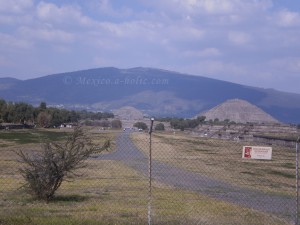 Teotihuacan, which in Nahuatl means City of the Gods or The place where gods are made is an ancient ceremonial center, one of the most important pre-Hispanic America due to its masterful urban layout, its monumental architecture and strong political and religious influence to other cities; it is also one of the most visited archaeological sites and values of Mexico, It is located in the municipality of San Juan Teotihuacan in the east of Mexico City. Teotihuacan was inscribed on the List of World Heritage by UNESCO in 1987. Through time, Teotihuacan has established itself as a sample of the best architectural style in Mesoamerica as well as a mystical center where, according to the pre-Hispanic followers of spiritual traditions, each 21st March there are powerful cosmic forces that are distributed to the four cardinal points, ideal time to renew the energy of the human body.
Teotihuacan, which in Nahuatl means City of the Gods or The place where gods are made is an ancient ceremonial center, one of the most important pre-Hispanic America due to its masterful urban layout, its monumental architecture and strong political and religious influence to other cities; it is also one of the most visited archaeological sites and values of Mexico, It is located in the municipality of San Juan Teotihuacan in the east of Mexico City. Teotihuacan was inscribed on the List of World Heritage by UNESCO in 1987. Through time, Teotihuacan has established itself as a sample of the best architectural style in Mesoamerica as well as a mystical center where, according to the pre-Hispanic followers of spiritual traditions, each 21st March there are powerful cosmic forces that are distributed to the four cardinal points, ideal time to renew the energy of the human body.
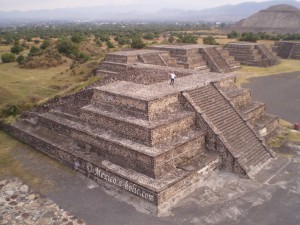 The Teotihuacan culture was initiated in the early Christian era and reached its magnificence between the third and fourth centuries; the area was abandoned, looted and burned around the year 800. The ancient metropolis has a main road called the road of the dead, from which magnificent ceremonial, social, civil and housing buildings were constructed, many decorated with magnificent murals which still remain as valuable example. It is oriented north to south, crosses the center of the archeological area, is 4 km long and 40m wide, and communicates the Citadel with the Square of the Moon. Here there are found the majestic pyramids of the Sun and the Moon, which are attributed an approximate age of 17 centuries. As well as other points of design sculptures and temples like the temple of Tlaloc, the temple Quetzalcoatl, the palace of Quetzalpapalotl, the palace of the Jaguars, the citadel and surrounding neighborhoods of Tetitla, Tepantitla, Zacuala, Yayahualco and Atetelco.
The Teotihuacan culture was initiated in the early Christian era and reached its magnificence between the third and fourth centuries; the area was abandoned, looted and burned around the year 800. The ancient metropolis has a main road called the road of the dead, from which magnificent ceremonial, social, civil and housing buildings were constructed, many decorated with magnificent murals which still remain as valuable example. It is oriented north to south, crosses the center of the archeological area, is 4 km long and 40m wide, and communicates the Citadel with the Square of the Moon. Here there are found the majestic pyramids of the Sun and the Moon, which are attributed an approximate age of 17 centuries. As well as other points of design sculptures and temples like the temple of Tlaloc, the temple Quetzalcoatl, the palace of Quetzalpapalotl, the palace of the Jaguars, the citadel and surrounding neighborhoods of Tetitla, Tepantitla, Zacuala, Yayahualco and Atetelco.
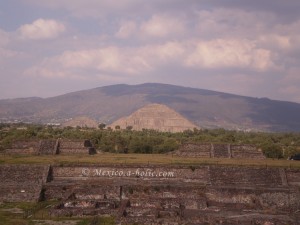 The Citadel is located at the southern end of the ceremonial center. It was built around 200 B.C. as a quadrangle, with 400m extension. There are found here some important religious buildings like the Temple of Quetzalcoatl, which is one of the main buildings of the archaeological site, dedicated to the deity of the same name; it is a central shrine housing complex. It has a facade that holds snakeheads accompanied by shells and aquatic snails, as well as representations of Tlaloc, the god of rain, and the Quetzalcoatl or the feathered-serpent.
The Citadel is located at the southern end of the ceremonial center. It was built around 200 B.C. as a quadrangle, with 400m extension. There are found here some important religious buildings like the Temple of Quetzalcoatl, which is one of the main buildings of the archaeological site, dedicated to the deity of the same name; it is a central shrine housing complex. It has a facade that holds snakeheads accompanied by shells and aquatic snails, as well as representations of Tlaloc, the god of rain, and the Quetzalcoatl or the feathered-serpent. 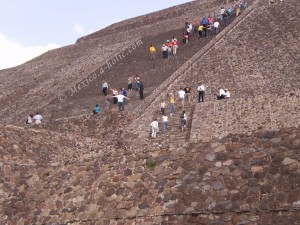 The pyramid of the sun is located in the center of the ruins, it was built between years 1 and 150 a.C, on a natural cave, and rises up to 63 meters, and it has a square base of 222 x 225 meters. The front of the building faces the west and there are stairs that lead to the summit. The Pyramid of the Moon is located in the north end of the road of the dead; it was built between years 1 and 170 a.C., it has a square base of 150 x 120 meters and 42 high. In front of this pyramid there is an unusual structure which houses 10 small shrines, and also has attached a small pyramid.
The pyramid of the sun is located in the center of the ruins, it was built between years 1 and 150 a.C, on a natural cave, and rises up to 63 meters, and it has a square base of 222 x 225 meters. The front of the building faces the west and there are stairs that lead to the summit. The Pyramid of the Moon is located in the north end of the road of the dead; it was built between years 1 and 170 a.C., it has a square base of 150 x 120 meters and 42 high. In front of this pyramid there is an unusual structure which houses 10 small shrines, and also has attached a small pyramid.
Quetzalpapalotl Palace also known as “Palace of the Butterflies” is perhaps the most luxurious building in the site and one of the most important. It was the residence of a notable and influential person. It is widely decorated with well preserved murals, especially the color red that was a favorite of that civilization. The lower parts of the building retained its original color. It has a courtyard, called the courtyard of Jaguars, because of the remains of wall paintings of the rooms surrounding the courtyard which in some cases have shells, seashells and plumes but most of these referring to the feline.. It is thought there are graphic representations of a ritual to bring rain; it was built between 450-650 a.C. . 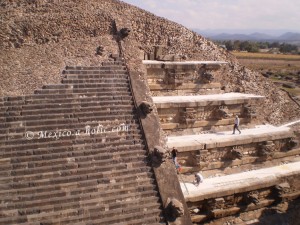 Within this zone there are also archaeological museums and research centers like the Center for Teotihuacan’s, dedicated to study of the Teotihuacan culture and the promotion of tourism services. As well as the Museum Manuel Gamioque, with temporal exhibitions, an auditorium, library and a 2000 base with maps, and archeological projects. In the Museum of the archeological site it is possible to watch works in obsidian, ceramic, shells and bones made by the ancient inhabitants. There is also the Teotihuacan’s paintings museum, where we can find a lot of wall paintings that have been rescued over the excavations; they are represented in rituals, ceremonies, deities and scenes from everyday life. Teotihuacan Culture Museum shows the stages of development of Teotihuacan culture in this city, and pieces got from the many excavations. It also features a scale model of the archaeological site.
Within this zone there are also archaeological museums and research centers like the Center for Teotihuacan’s, dedicated to study of the Teotihuacan culture and the promotion of tourism services. As well as the Museum Manuel Gamioque, with temporal exhibitions, an auditorium, library and a 2000 base with maps, and archeological projects. In the Museum of the archeological site it is possible to watch works in obsidian, ceramic, shells and bones made by the ancient inhabitants. There is also the Teotihuacan’s paintings museum, where we can find a lot of wall paintings that have been rescued over the excavations; they are represented in rituals, ceremonies, deities and scenes from everyday life. Teotihuacan Culture Museum shows the stages of development of Teotihuacan culture in this city, and pieces got from the many excavations. It also features a scale model of the archaeological site.
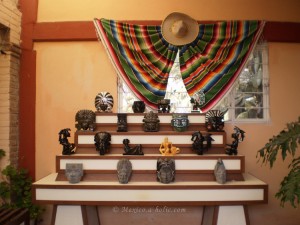 In the village of San Juan Teotihuacan and its surroundings there are several markets and shops selling all kinds of crafts: figures made of obsidian (volcanic glass of a dark color typical of the region), tin work and figures made of clay, representations of the image of the ancient pre-Columbian gods. In this same place, every Monday, there is a market, where besides tasting delicious culinary samples people can buy various handicrafts as souvenirs for remembering this beautiful site.
In the village of San Juan Teotihuacan and its surroundings there are several markets and shops selling all kinds of crafts: figures made of obsidian (volcanic glass of a dark color typical of the region), tin work and figures made of clay, representations of the image of the ancient pre-Columbian gods. In this same place, every Monday, there is a market, where besides tasting delicious culinary samples people can buy various handicrafts as souvenirs for remembering this beautiful site.
Photos were made on 14-12-2009 by Diana Navarro and Diego Voors
